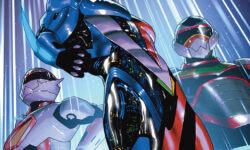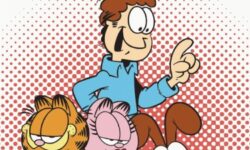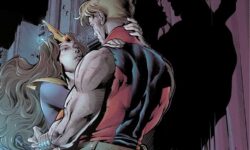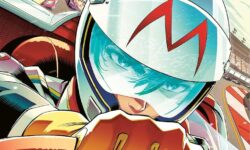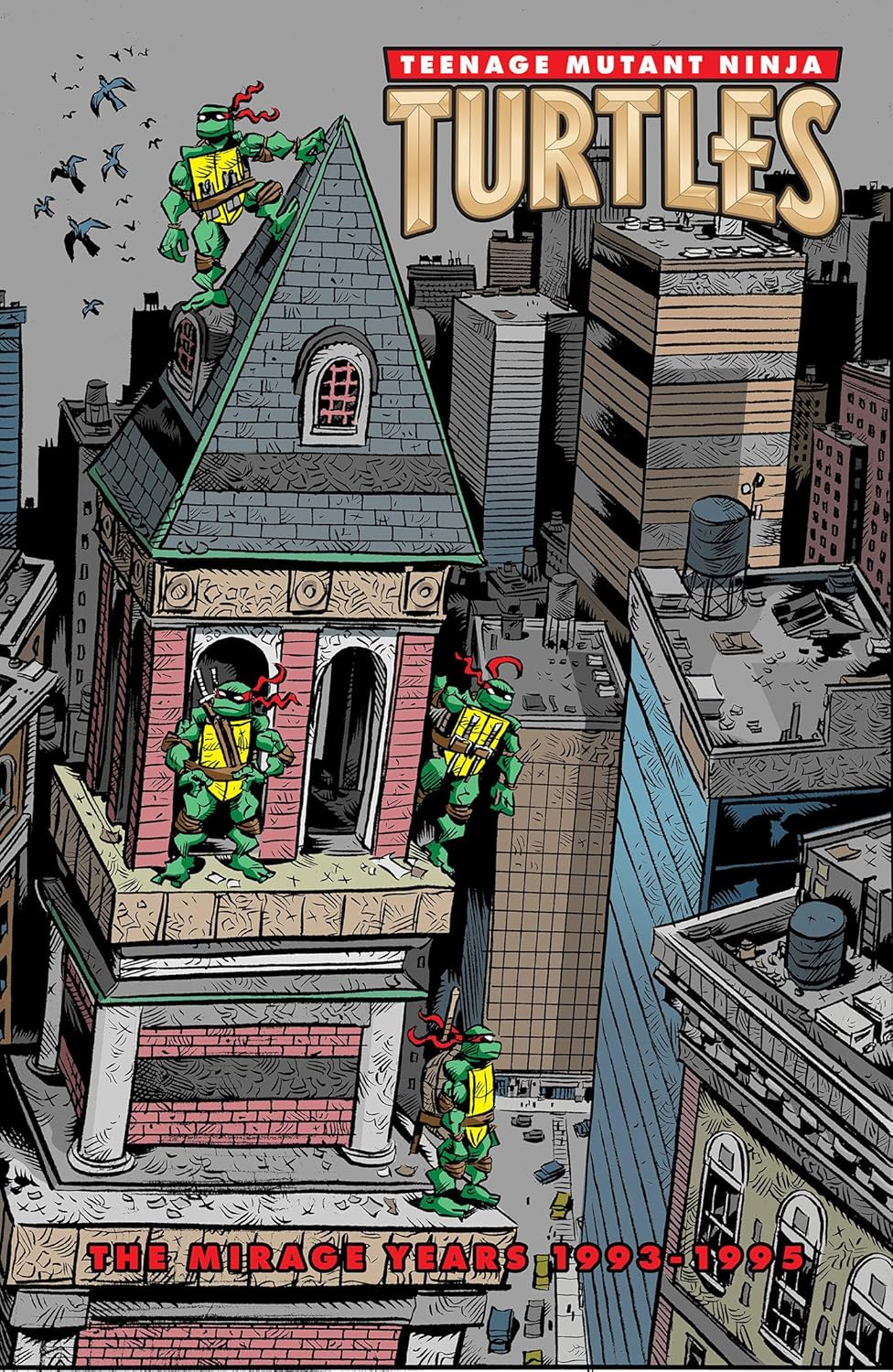
This coming Tuesday, comics publisher IDW will take fans of the Teenage Mutant Ninja Turtles back to the Turtles’ Mirage years once again when it releases the new anthology, Teenage Mutant Ninja Turtles: The Mirage Years 1993-1995. A rebirth of sorts for the Turtles (after its initial run on Mirage ended after 62 issues), the franchise’s second run on Mirage would also be its last for the company, which was also founded by the Turtles’ creators, Peter Laird and Kevin Eastman, spanning only 13 issues. This 300-page-plus anthology culls all 13 issues in one complete story, which fully ends the band’s run with the studio that saw the Turtles’ roots. This is at the heart of the anthology. Building on the foundation formed by that item is the story contained in the anthology’s pages. It is a mostly successful story despite at least one concern, which will be addressed a little later. The artwork exhibited throughout the story rounds out its most important elements. It will also be examined later. Each item noted is important to the whole of Teenage Mutant Ninja Turtles: The Mirage Years 1993-1995. All things considered, they make this anthology a must for any TMNT fan, from the established reader to beginners alike.
IDW Publishing’s forthcoming release of Teenage Mutant Ninja Turtles: The Mirage Years 1993-1995 is a presentation that every fan of the Turtles will appreciate. That is due in part to its very presentation. Spanning 359 pages, the anthology features all 13 issues of the series’ second run on Mirage comics. That run, as noted, would be the last for Leonardo, Donatello, Michelangelo, and Donatello for the studio that itself was founded by the Turtles’ creators. This is key in that having all 13 issues in one place means readers no longer have to worry about hunting the dark corners of the internet and comics shops for these issues anymore. Given, the price tag of roughly $60 (with tax) puts each issue at nearly $5, it is still worth the money since it means getting to read this key part of the Turtles’ history that is otherwise hard to find.
Building on the foundation formed by the anthology’s very presentation is the story contained herein. The story in question picks up where the series’ first run on Mirage ended. The events of the “City at War” story now find the “brothers” having gone their separate ways. Donatello has left with Splinter while Leonardo, Donatello, and Raphael are living with Casey, April and Casey’s daughter Shadow (from his previous marriage, which is explained in that initial run). The second run’s lead issue at first seems random, but as the story progresses along its 13 total issues, that lead issue makes even more sense. Case in point is April having a nightmare in which she sees her former boss, Baxter Stockman having wires coming from his head. Even Casey’s equally random dream involving a much bigger, more muscle bound version of himself makes more sense as the story reaches its final act in Issue #13. Even that final scene in which two of the Turtles end up in a lab and are being examined by a Triceraton and another alien makes sense in the final act. The only part of that first issue’s story that is left up in the air is Donatello’s dream about burying Splinter, which opens the issue. Perhaps that was left open-ended because the Turtles’ run on Mirage ended after these 13 issues. Even the very fact that dreams being at the root of everything makes full sense by the story’s end.
Now having noted this, the story finds Leonardo, Donatello and Raphael initially at Casey and April’s apartment, following the events of “City at War.” When Raphael decides to move out, Mikey and Leo end up moving out, too, essentially splitting up the “brothers.” But when Baxter Stockman breaks into a secret D.A.R.P.A. lab and puts his brain into a deadly robot, all four of the guys are forced to reunite to stop him. They manage to defeat Stockman, but in the process, Raphael is captured by federal agents after Stockman drops him from a rooftop, leading Michelangelo, Leonardo, and Donatello (accompanied by Casey and a couple of other unlikely companions) to track him down at the same D.A.R.P.A. lab. On a side note, the lab in question is clearly supposed to be Area 51, just with another name. The whole thing culminates with a giant battle between the Turtles, soldiers at the base and a whole force of Triceratons. Good obviously triumphs and there is an epilogue of sorts that wraps things up, wrapping up everything nicely for the Turtles’ second and final run on Mirage comics. Audiences will be left to read everything for themselves so as to not spoil anything for those who have not yet read this run. Keeping all of this in mind, the whole of the 13-issue’s story is again mostly successful and is sure to keep readers engaged and entertained.
Building on the engagement and entertainment ensured through the story is the artwork that accompanies that presentation. As former TMNT writer Jim Lawson points out in his introductory notes to the anthology, audiences can see a clear comparison to Frank Miller’s The Dark Knight saga in the artwork here. That is evident in the gritty, rough design style and the coloring. That raw look and feel of the artwork still gives the series its own identity even considering the stylistic comparison. What’s more, the artwork is far more explicit in its presentation than most comic books past and present — another similarity in style to Miller’s run on Batman. So much of this is unlike much of what is out there in comic books and graphic novels today. To that end it shows, perhaps a difference in what was acceptable even in comics at that time versus today. It was clearly not meant for children. That unique identity that the artwork has contributed to the anthology works with the story in these pages to make for even more appeal among the most devoted longtime TMNT fans. When the overall content is considered alongside the anthology’s very presentation, the whole therein make Teenage Mutant Ninja Turtles: The Mirage Years 1993-1995 another successful TMNT anthology from IDW Publishing that will appeal to so many fans of the Teenage Mutant Ninja Turtles.
IDW Publishing’s forthcoming Teenage Mutant Ninja Turtles comics anthology, Teenage Mutant Ninja Turtles: The Mirage Years 1993-1995 is a mostly successful offering that will appeal to a wide range of TMNT fans. That is due in part to its presentation. In regard to the presentation, readers get here, the Turtles’ second run on Mirage from beginning to end. That means audiences no longer have to scour comics shops and online outlets for these otherwise hard to find issues. The story herein is of its own appeal as it picks up right where the Turtles’ first run on Mirage ended and moves fluidly from beginning to end. There is only one item in the story that is left up in the air, and that could have been for any reason. The artwork presented throughout is familiar for its stylistic comparison to Frank Miller’s work on the famed Batman franchise. Each item noted is key in its own way to the whole of Teenage Mutant Ninja Turtles: The Mirage Years 1993-1995. All things considered they make the anthology a welcome read for any established and newer TMNT fan.
Teenage Mutant Ninja Turtles: The Mirage Years 1993-1995 is scheduled for release Tuesday in comics shops nationwide. More information on this and other titles from IDW Publishing is available at:
Website: https://idwpublishing.com
Facebook: https://facebook.com/idwpublishing
Twitter: https://twitter.com/IDWPublishing




